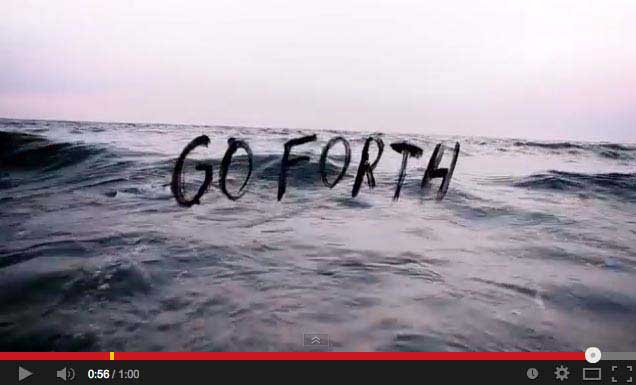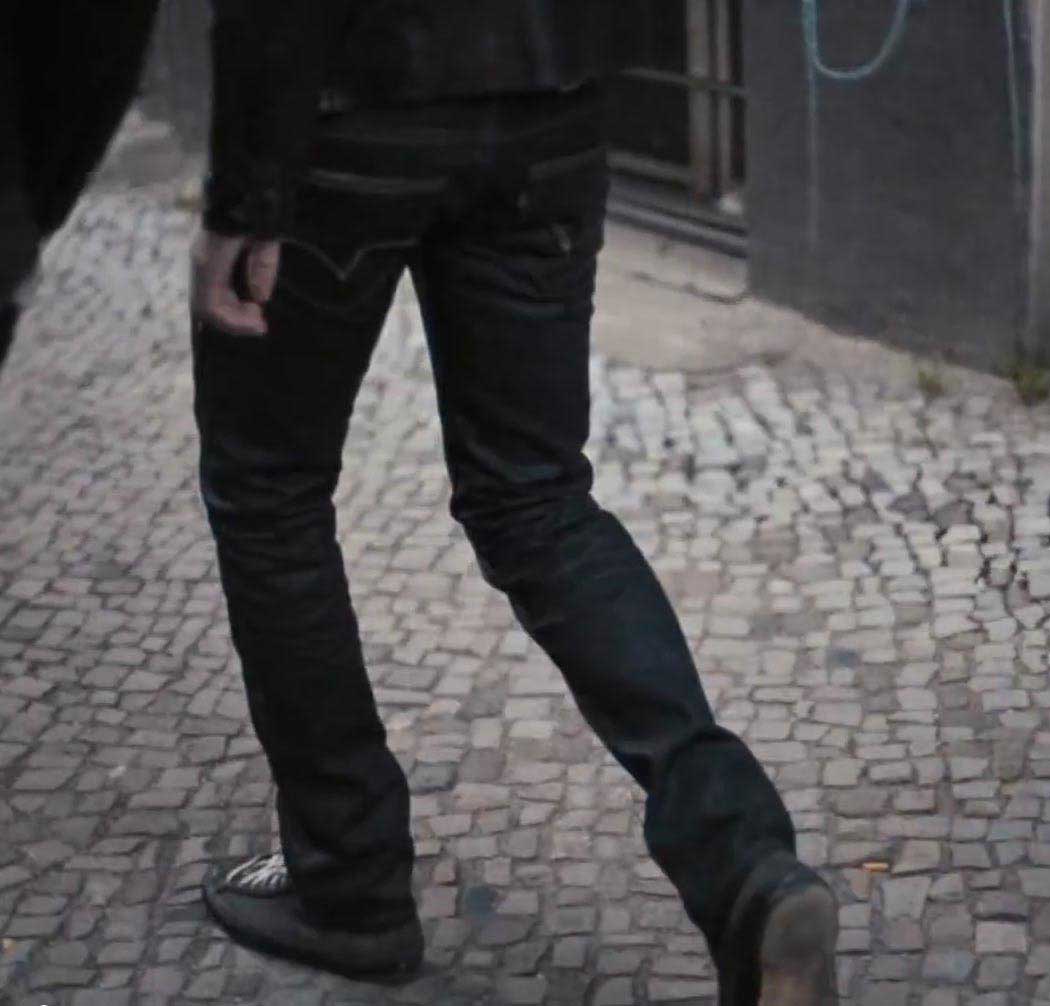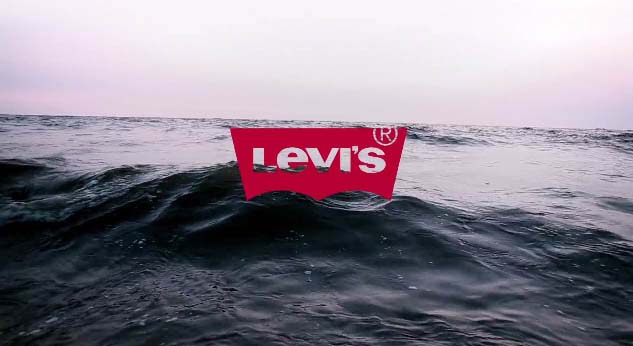

Iedema's concepts of representation and orientation are useful in analyzing the characters in this commercial. First is representation or "what is the subject which the shots portray and what it, he, she or they is/are doing" (Iedema qtd. in Van Leeuwen & Jewitt 191). The subjects in this commercial are all attractive young people who are doing activities that could connotatively convey freedom. The subjects are staring out into the ocean or the urban landscape. They are walking through crowded city streets and having sexual encounters in pools. While none of the subjects are denotatively conveying their freedom and liberty in being young (and wearing Levi's), the messages of their activities are obvious to some young millennial viewers because of naturalized codes. According to Hall,
"Simple visual signs may appear to have achieved a 'near-universality' in this sense: though evidence remains that even apparently 'natural' visual codes are culture-specific. However, this does not mean that no codes have intervened; rather, that the codes have been profoundly naturalized" (Hall 170) |
Secondly, orientation is important in this commercial. According to Iedema, "orientation is to do with how meanings position characters and readers-viewers" (Iedema qtd. in Van Leeuwen and Jewitt 192). In this commercial, the subjects are positioned away from the viewers. It is rare that the characters in the commercial are looking directly at the camera. Usually, they are facing away from the camera, intensely involved in what they are doing. In other words, in their denial of direct contact with the viewer, the subjects make an 'offer' instead of a demand. Accordingly, "[an image with indirect contact] 'offers' the represented participants to the viewer as items of information, objects of contemplation, impersonally, as though they were specimens in a display case" (Kress and Van Leeuwen 119). Kress and Van Leeuwen stress that offer photos make the viewers feel as if the subjects of the image cannot see them. The viewers feel as if "a real or imaginary barrier is erected" in which the subjects in the image do not know that they are being watched (Kress and Van Leeuwen 120). In this way, this commercial is voyeuristic in nature. Voyeurism is receiving pleasure in watching someone without being watched yourself and it often lends power to the viewer (Ott & Mack 161). This power derived from voyeurism is often seen as an active male characteristic of visuality, which creates the male gaze (Mulvey 397, 400). Since the subjects in the commercial are oriented away from us and we can see them without them seeing us, they are unknowingly offering us something. Part of the male gaze is the concept of the castration complex, or males' desire to have power over the female for fear that she will castrate them (Mulvey 399). Mulvey's foundational work gave way to the belief that males objectify females or practice fetishtic scopophilia in the cinema (or in this case, commercials)
in order to resolve their fear of castration by symbolically castrating females.

While this commercial displays women as beautiful objects, it does the same to men, albeit to a lesser extent. Because the subjects in the commercial are displayed away from the camera, the viewer sees a lot of close-up shots of the subjects' butts. There are many close-ups of both the male and female butt, which is ostensibly to show the product, the Levi's jeans. Advertising is famous for exploiting the female body to sell products, but as Berger notes, recent trends in advertising reveal that the male body is also being exploited (Berger 73).

|
These displays of the female butt are easy to view with the concept of Mulvey's male gaze and Lewis' concept of women's narcissistic double-desire. Lewis says, "it is for 'his' eyes that the [woman's] magazines' consumers study the arts of beauty and dress," meaning that women like to view objectified beautiful women in the media because they themselves desire to be objectified, and thus desired by males (Lewis 656). However, the purpose of the male's objectified butt is somewhat murkier. First of all, it is key to note that the male butt is objectified less often and less intensely than the female's in this advertisement. The male butt is more often displayed while walking or otherwise being active. Nevertheless, the male butt is an object, not a subject. The male butt is incapable of making decisions and relating to the world around it. It is there to be seen. In a world that is more egalitarian in terms of gender than the world of Mulvey, it is possible that males also have a form of double-desire. Perhaps men desire to be objectified by women in order to be desired. While the male butt is an object, it is less of a sex object than the female butt, because of the aforementioned activeness of the male. Traditional characteristics of manly maleness include power, activeness, and the ability to provide protection to females. In this advertisement, women are frequently pictured standing in the wind passively, while men confront a group of riot police with combat shields and have flaming guitars. These contrasting representations of both genders provide subjects that both genders can identify with and can desire. In contrast to the notion of "sex sells," Williamson writes, |
"What the advertisement clearly does is thus to signify, to represent to us, the object of desire. Since that object is the self, this means that, whole ensnaring/creating the subject through his/her exchange of signs, the advertisement is actually feeding off that subject's own desire for coherence and meaning in him or her self. This is as it were the supply of power that drives the whole ad motor, and must be recognized as such" (Williamson 60).In other words, a male viewer of the advertisement can simultaneously desire the women in the advertisement because of their sexual objectification, and identify with the male subject in the advertisement because he holds characteristics that the male viewer also wants to have. A female viewer can desire the objectification of herself through the female subjects of the advertisement, as Lewis previously posited. In this way, the advertisement provides identification for both genders and thus interpellates both males and females as subjects for advertisement. |
 |
Another consideration in the orientation of male and female viewers is fantasy. Ott and Mack say, "A fantasy is a mental representation of conscious or unconscious wish fulfillment...Fantasy also importantly allows us to assume multiple perspectives" (Ott & Mack 165). The concept of fantasy is related to the aforementioned desire. Both men and women are positioned to desire or fantasize about someone in the commercial. Whether an audience member fantasizes about someone of their own or opposite gender, desire is powerful in this commercial. As Ott & Mack mentioned, part of fantasy is allowing us to identify with multiple perspectives, which helps explain the way males are positioned to view this commercial. Fantasy also relates to identification, which is part of orientation. Identification is important in visual texts because it gives viewers direction. A classic explanation of identification and its importance in visual media is through Lacan's mirror stage. The mirror stage is the bridge between Lacan's concepts of the Real and the Symbolic. In the mirror stage, "the child catches a glimpse of himself in a mirror and misrecognizes himself as an autonomous and total whole" (Ott & Mack 155). Correspondingly, he begins to see the relationship between himself and other things, and thus becomes a subject (Ott & Mack 156). Williamson posits that advertising is like the mirror stage because it "offers us an image of ourselves that we may aspire to but never achieve" (Williamson 64). We seek to identify with the subjects on screen so that we can narcissistically see our place in the scene. Identification with the subjects in this advertisement is a particularly powerful form of interpellation.
Identification becomes even more powerful when considering what content the advertisement is actually showing. Levi's does not use a 'hard sell' of the product in which the product's features are explained, but rather a 'soft sell,' which ultimately takes the form of selling a lifestyle and the corresponding cultural values and myths (Hill 5). Because of this advertising tactic, it is necessary that the commercial interpellates consumers so that they see their own place in the scene. Of the cinema, Metz said, "films release a mechanism of affective and perceptual participation in the spectator..." (Metz 4). Metz reasons that a viewer watching a film feels more a part of the film than someone viewing a still photograph because the film is happening in current time, while a photograph has already happened (Metz 6). The movement and cinematic quality of this advertisement creates a similar effect and the target audiences can see themselves in the commercial. This is another function of the way we generally see the subjects of the commercial facing away from us; it is almost as if we could jump into the scene and "go forth" with them. This advertisement interpellates the same type of subjects that it presents and we are made to identify with them and their corresponding lifestyle. Williamson says,
"We are both product and consumer; we consume, buy the product, yet we are the product. Thus our lives becomes our own creations, through buying; an identikit of different images of ourselves, created by different products" (Williamson 70).This commercial does show the product in the close-ups of the subject's butts, but the majority of the commercial is not centered around displaying the product, but rather the activity of the characters in the commercial. The commercial shows us a better version of ourselves that we misrecognize as being possible to attain.

Berger, Arthur A. Ads, Fads, and Consumer Culture: Advertising's Impact on American Character and Society. Lanham, Md: Rowman & Littlefield Pub, 2004. Print.
Hall, Stuart. "Encoding/Decoding." In Media & Cultural Studies: Keyworks, edited by Meenakshi Gigi Durham and Douglas M. Kellner, 166-176. Malden, MA: Blackwell, 2001. Print.
Hill, Dan. About Face: The Secrets of Emotionally Effective Advertising. London: Kogan Page, 2010. Print.
Kress, Gunther R, and Leeuwen T. Van. Reading Images: The Grammar of Visual Design. London: Routledge, 2006. Print.
"Levi's: Go Forth - "Legacy" | Video - FreshnessMag.com." FreshnessMag. N.p., 9 Aug. 2011. Web. 24 Apr. 2014. Link.
Lewis, Reina, "Looking Good: The Lesbian Gaze and Fashion Imagery," in Nicholas Mirzoeff (ed.), The Visual Culture Reader 2nd Ed, (London: Routledge, 2002), pp. 654-668.
Metz, Christian. Film Language: A Semiotics of the Cinema. Chicago: University of Chicago Press, 1991. Print.
Mulvey, Laura. "Visual Pleasure and Narrative Cinema." In Media & Cultural Studies: Keyworks, edited by Meenakshi Gigi Durham and Douglas M. Kellner, 393-404. Malden, MA: Blackwell, 2001. Print.
Ott, Brian L, and Robert L. Mack. Critical Media Studies: An Introduction. Chichester, U.K: Wiley-Blackwell, 2010. Print.
Van, Leeuwen T, and Carey Jewitt. Handbook of Visual Analysis. London: SAGE, 2001. Print.
Williamson, Judith. Decoding Advertisements: Ideology and Meaning in Advertising. New York: Boyars, 1984. Print.